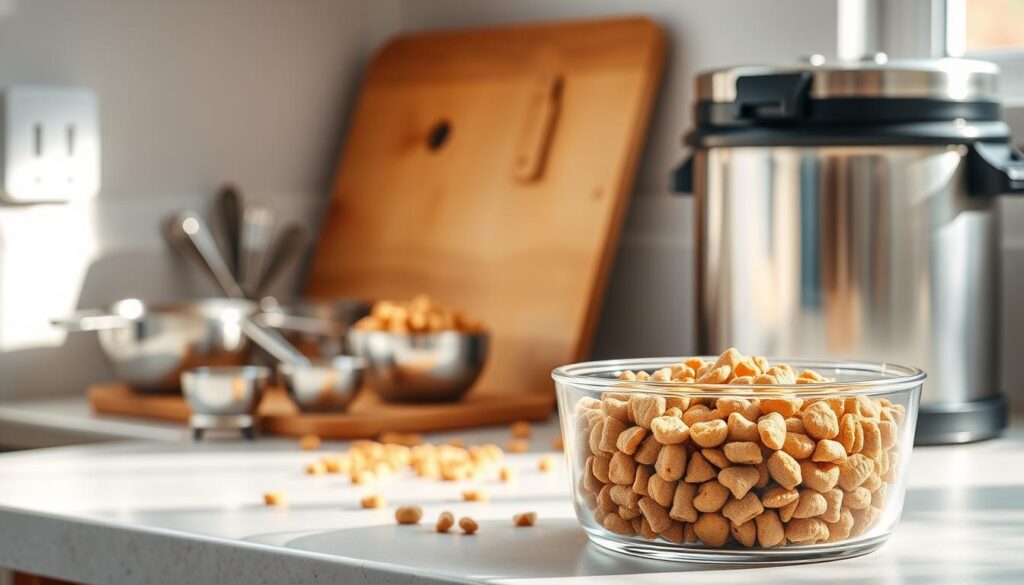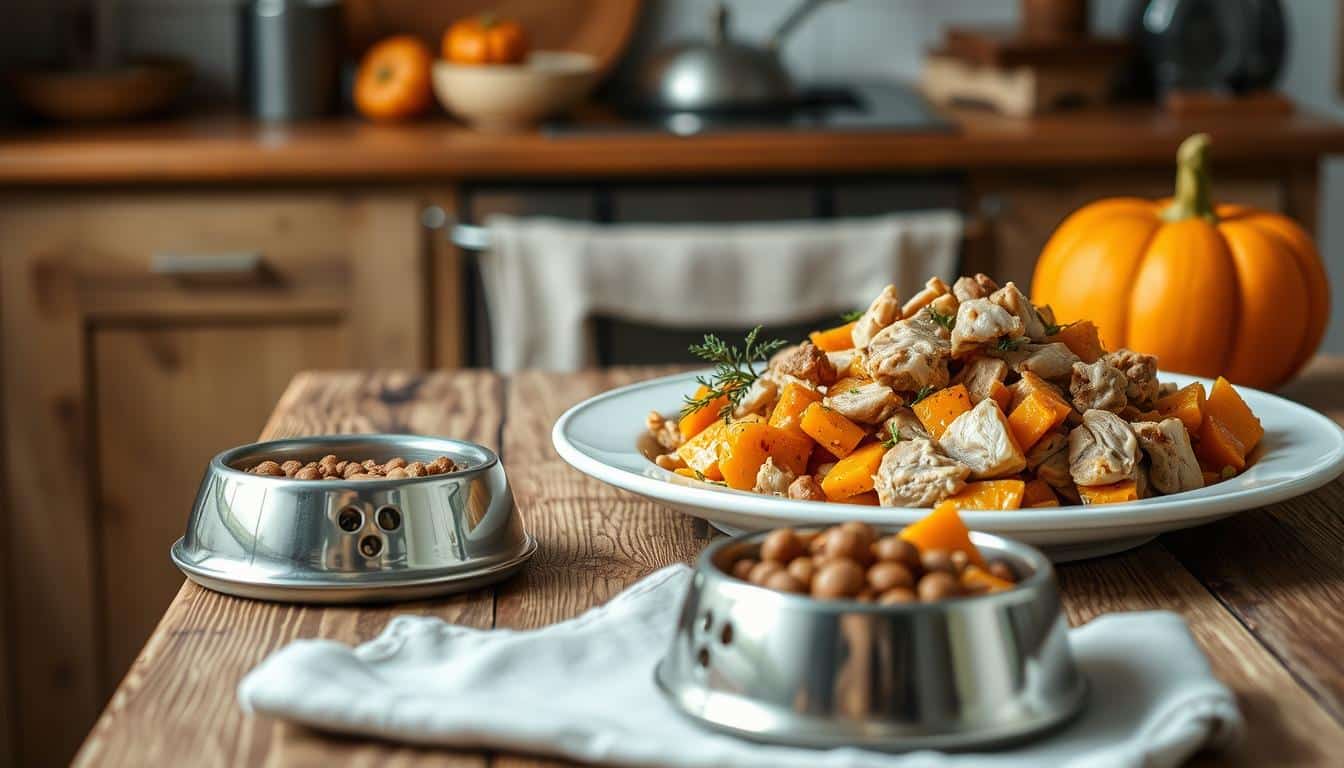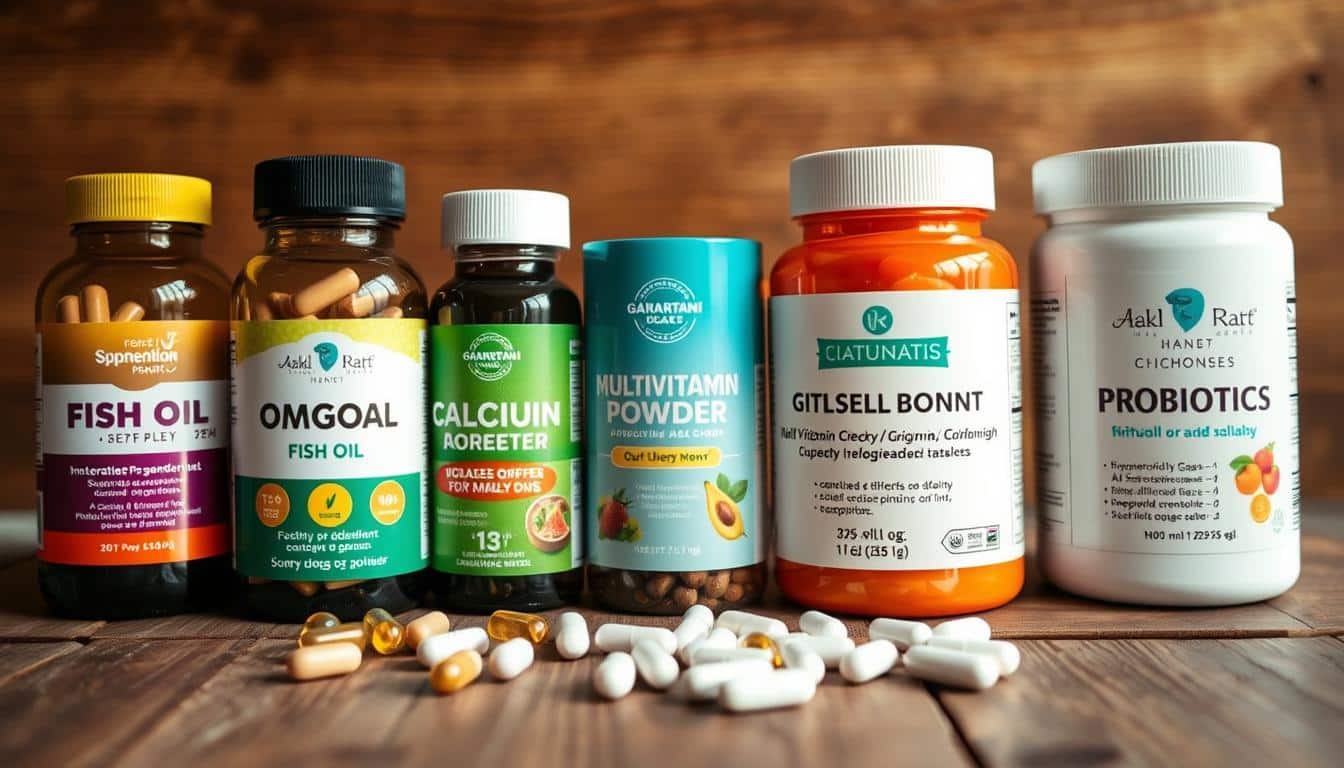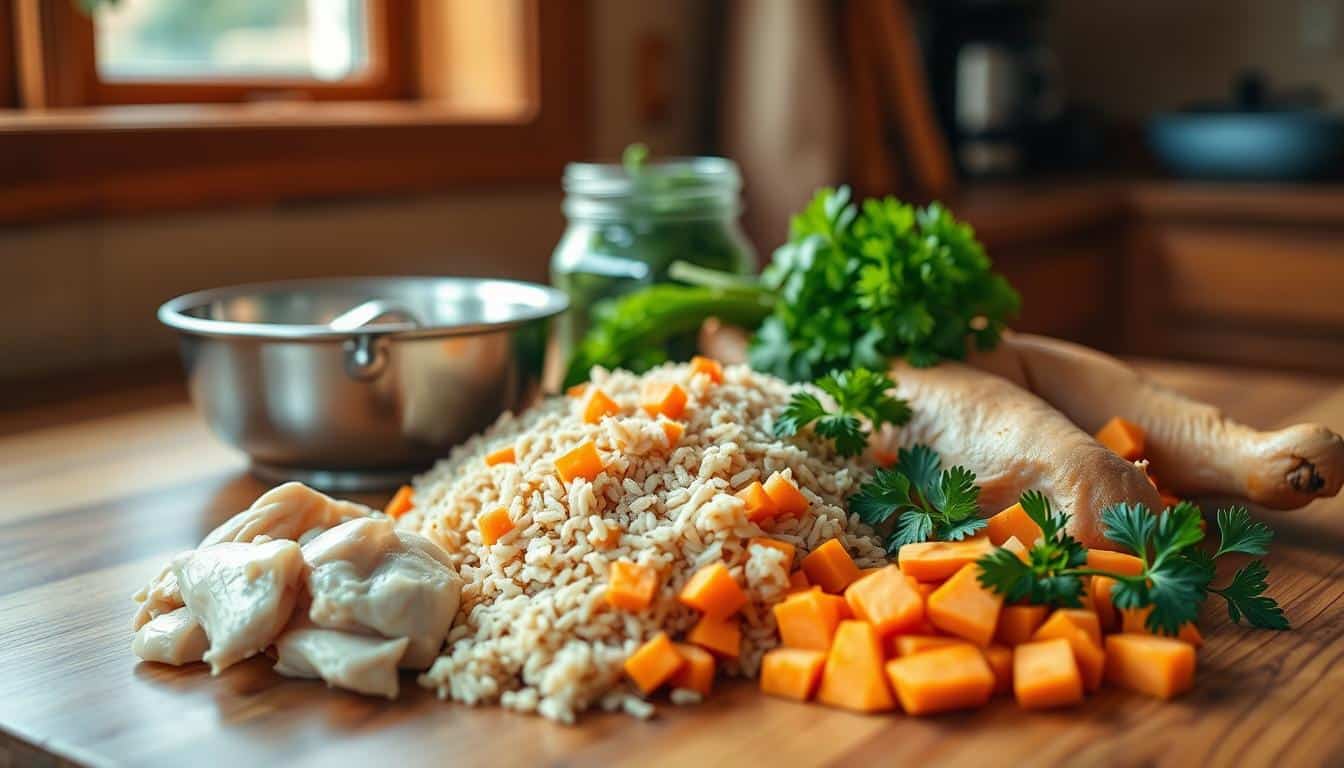Feeding a small dog at home is simpler than it seems. In this guide, we explain how to figure out food amounts for small dogs. We focus on making sure it’s accurate, balanced, and safe.
Many owners prefer homemade food for better ingredient control and safety. Whole foods improve skin, coat, and digestion. But, planning and making homemade meals takes time and can cost more than dry food.
Talk to your vet or a nutrition expert before changing your dog’s diet. Look for trusted recipes from sources like MSPCA-Angell. Watch your dog’s weight, skin, poop, and pee to make sure the new diet works.
Useful tools can make meal prep easier. A gram scale measures food accurately. A food processor blends everything well. And, use quality supplements like BalanceIT if needed. ChefPaw can help you prepare meals while keeping an eye on nutrition and portion size.
This guide helps manage your small dog’s diet. It covers how much to feed, the trade-offs, and what to monitor. It’s all about keeping your little buddy healthy and happy with homemade meals.
Why choose homemade dog food for small breeds
Owners of small breeds often think about the balance between ease and oversight. Making food at home lets you see what’s in every meal. This lets owners adjust meals to their tiny friends’ mouths and health needs, like skin and digestion.
Control over ingredients and recalls
When you cook at home, you can choose fresh ingredients from trusted places. You can check how fresh the meat is and where your grains come from. This helps avoid problems like recalls that some store brands face.
Potential health benefits for skin, coat, and digestion
Owners see better skin and shinier coats with homemade meals. Good proteins and fats, plus omega-3s, are key. They help with skin and coat care. Gentle fibers and carbs help with digestion too.
Trade-offs: time, cost, and planning
Making food at home requires time and effort. Costs may be more than dry food but less than special services. Changing recipes helps keep picky eaters happy.
- Use vet-approved recipes to ensure your pet gets what they need.
- Prepare meals in advance to make busy days easier.
- Include necessary supplements to prevent missing nutrients.
Knowing the benefits of homemade food helps make a choice. Think about the benefits and efforts needed for your small pet.
Understanding essential nutrients for small-breed dogs
Small-breed dogs have quick metabolisms and small bodies. They need a balanced diet with protein, fats, carbs, fiber, vitamins, and minerals. This guide will discuss each nutrient and suggest food sources for home cooking.
Protein and essential amino acids specific to dogs
Dogs need proteins that have ten essential amino acids they can’t produce themselves. Great protein sources include chicken dark meat, turkey, beef, lamb, and some fish like salmon. For small dogs, an example is giving 80 g of cooked chicken dark meat to a 15-lb dog.
Fats and fatty acids for skin, coat, and energy
Fats give dogs energy and keep their skin and coats healthy. Use oils like canola or flaxseed, and add fish oil for omega-3s. A small dog might get 5–10 g of vegetable oil, with a bit of salmon and coconut oil for balance.
Carbohydrates and fiber sources appropriate for small breeds
Carbs are a key energy source. Choose foods like rice, pasta, potatoes, oatmeal, or quinoa. For fiber, add pumpkin, peas, green beans, or carrots to help with digestion. A meal for a small dog could include 190 g of cooked rice and a spoon of mixed veggies.
Vitamins and minerals to prevent deficiencies and excesses
Vitamins A, B, C, D, E, K, and essential minerals are crucial for health. Calcium and phosphorus are especially important for growing dogs. Many vets suggest a supplement to make sure dogs get all the nutrients, and keeping fresh water available is important too. Always check your dog’s urine pH, especially if they have urinary problems.
- Protein sources: chicken, turkey, beef, lamb, salmon
- Fat sources: salmon oil, fish oil, canola, flaxseed oil
- Carbs and fiber: rice, oatmeal, pumpkin, green beans
- Supplements: veterinary canine multivitamin/mineral formulas
Daily portions for small-breed homemade diets
Finding the right amount of food keeps small dogs healthy and full of life. Start by estimating how many calories they need. Then, adjust food amounts based on their body shape and if they get more or less active. It’s best to use real meal plans and advice from places like MSPCA-Angell or a food expert for pets when you can.
Estimating caloric needs by weight and activity
To figure out food needs, there’s a simple math formula you can use. For instance, a 15-lb adult dog might need about 443 kcal every day. Depending on whether they’re more or less active, this number could go up or down by half.
Keep an eye on their weight and how they look. Adjust their food if they start getting heavier or thinner. If you’re not sure what to do, it’s a good idea to talk to your vet.
Example portion guide for a 10–20 lb small-breed adult
A chart for a 10-20 lb dog can help you know how many grams of food they need. For a 15-lb dog, MSPCA-Angell suggests around 300 g/day, which is about 440–453 kcal. You’ll give less food to a smaller dog and more to a bigger one, based on their size and activity.
For a 20-lb dog, you might feed them a special vet’s recipe that includes 8 oz of ground turkey thigh, 2 tbsp of organ meat, 1/4 cup of grated veggies, along with some oils, seeds, and calcium citrate. Change the food amounts based on the dog’s weight and how active they are to meet their calorie needs.
Adjusting portions for weight change, age, and activity
Change food amounts slowly. For weight changes, adjust their diet by about 25% at a time until they look healthier.
Dogs that are puppies, pregnant, or nursing might need special eating plans. Very active small dogs might need a lot more calories. Watch how they look and change their diet as needed.
Weighing food vs. measuring by volume for accuracy
It’s better to weigh dog food instead of measuring by cups to get the nutrition right. Differences in how much water is in the food and how long it’s cooked can change its weight, so using a gram scale helps you give the right portions. This also makes sure all the added nutrients and ingredients are correct.
Weighing the food helps stop selective eating which can leave gaps in their nutrition. Use a kitchen scale and write down how much they’re eating to make it easier to change their diet later.
Sample balanced recipes and portion breakdowns
Here are some examples to try, checked by vets. They show cooked weights, how to make them, and tips on adding vitamins and meal sizes. Use a scale and mix things well. This stops dogs from only eating parts they like and keeps meals the same.
M veterinarian-formulated recipe (scaled from MSPCA-Angell) — for a 15-lb adult
- Cooked chicken dark meat: 80 g (protein)
- Cooked white rice: 190 g (~1 1/3 cups cooked)
- Mixed vegetables: 15 g (~1 tbsp, finely chopped)
- Vegetable oil: 5–10 g (1–2 tsp)
- BalanceIT Canine supplement: 6 g (1.5 black scoops)
This recipe weighs about 300 g and has about 1.51 kcal/g, totaling around 443 kcal/day. Mix everything well before dividing it up. This way, your dog gets the right mix of nutrients. This recipe, designed by MSPCA-Angell, is great for keeping adult dogs healthy if you use the listed supplement.
Turkey-and-vegetable recipe for a small adult dog — example for ~20-lb adult
- Ground organic turkey thigh (boneless): 227 g (8 oz)
- Ground turkey organ meat (liver/gizzards/hearts): 2 tbsp
- Finely grated organic vegetables: 1/4 cup
- Ground raw sunflower seeds: 1 tsp
- Coconut oil: 1/2 tsp; salmon oil: 1/2 tsp
- Calcium citrate: 500 mg added after cooking
For this recipe, blanch the veggies and cook the turkey until it’s mostly white. Then, blend the veggies until they’re really fine, mix it all together, and let it cool before you feed it. This turkey meal has the right balance of protein, fat, and fiber for small dogs, especially when you add in the specified calcium and oils.
How to scale recipes for different small-breed weights
- Multiply each ingredient by the ratio of target weight to reference weight. For the turkey recipe use 2× for 40 lb, 3× for 60 lb, 4× for 80 lb.
- Calculate prepared food kcal per gram, then feed grams that meet the dog’s estimated energy needs.
- Re-weigh and reassess weekly; adjust intake by about ±25% to reach desired body condition and activity level.
To adjust dog recipes for weight, keep vitamin doses right or follow the product’s guide for different sizes. This ensures meals stay regular in portion and nutrients.
Supplements and how to ensure a complete balanced diet
Homemade diets can be nutritious if they’re complete. Yet, veterinarian-crafted recipes often need a vitamin and mineral boost for dogs. It’s vital to pick supplements based on the dog’s life stage, weight, and vet’s lab results.
When to add a canine-specific vitamin/mineral supplement
Add a supplement if a recipe isn’t “complete and balanced” according to a veterinary nutritionist. BalanceIT is a common choice used by vets in MSPCA-Angell recipes. For a 15-lb dog, about 6 g/day might be recommended, but doses can differ. Always ask your vet or an ACVN diplomate before using any products.
Essential supplemental nutrients: calcium, omega-3s, and trace minerals
Growing puppies and breeding dogs need the right balance of calcium and phosphorus. Choose a good dog calcium supplement instead of guessing with human foods. Wrong amounts can lead to bone issues.
Fatty acids help reduce inflammation and keep the skin and coat healthy. Add omega-3 from fish or salmon oil as some recipes suggest. Occasionally, cod liver oil is okay but be cautious about vitamin A and D levels.
It’s easy to overlook trace minerals and fat-soluble vitamins. Make sure you get enough zinc, iodine, selenium, copper, vitamins A, D, E, K, and the B complex. A formulated supplement can ensure your dog gets these consistently.
Risks of missing supplements: growth, bone, and metabolic issues
Not getting the right nutrients can cause gaps or toxic excesses over time. Puppies that don’t get enough calcium or have improper calcium:phosphorus ratios might face growth issues or deformities.
Feeding unapproved recipes for a long time can strain your dog’s metabolism and organs. Regular vet visits, monitoring body condition, and occasional blood tests can minimize risks and help spot any deficiencies early.
- Ask your veterinarian to confirm the right product and dose.
- Record supplement brand, batch, and daily amount for follow-up visits.
- Adjust supplements when life stage or weight changes occur.
Safe preparation, storage, and food-safety practices
Making meals safe for small dogs starts with clean kitchens. We use simple tools and time everything just right. This way, each meal is safe and the same as the last.

Kitchen tools and setup
Start with a digital gram scale, a sturdy blender or food processor, and the right pots and pans. Getting a scale and food processor just for pet food makes repeating recipes easy. It also helps cut down on waste.
- Keep a special clean area for preparing dog food. This keeps dangerous foods away.
- Have a separate cutting board and utensils just for pet meals. This stops germs from spreading.
- For storing, pick containers or bags that are safe and labeled for freezing.
Cooking, blending, and portioning
Proteins need cooking until they’re safe but still tender. Slow cook turkey and fully cook chicken to kill off bad germs. Lightly cook veggies to aid in digestion.
Blend the food so your dog can’t ignore veggies or supplements. A smooth mix stops picky eating and keeps their diet balanced.
Using a scale to measure food lets you serve exact amounts. Weighing each meal ensures small dogs get the calories they need.
Refrigeration and freezing timelines
Put fresh food in the fridge right after cooling. Homemade dog food should be used within three to four days to stay fresh and safe.
Freeze extra meals as single servings to make things easier. Frozen meals are good for up to two months. Don’t use food frozen for over six months.
- Always thaw food in the fridge before it’s time to eat.
- Write down the date and weight on containers to keep track.
- Test small batches of new recipes to see how your dog likes them.
Transitioning and monitoring your small dog on a homemade diet
Switching your small dog to a homemade diet needs careful planning. Begin with a clear plan, keep detailed records, and talk frequently with your vet. This helps you notice any issues early.
Consulting your veterinarian or a veterinary nutritionist first
Before starting with homemade dog food, talk to your vet. They can look at your dog’s health history and suggest what to do next. For help with recipes and making sure your dog gets what it needs, see a specialist or check out BalanceIT.
A dog vet nutritionist will make sure your recipe is right for your dog’s age and breed. This helps avoid missing important nutrients that could affect your dog’s growth or health.
Gradual transition plan to avoid digestive upset
Gradually switch your dog’s food over 5 to 7 days. Start with a mix of 75% old food and 25% homemade for the first two days. Then, adjust the mix before going fully homemade.
If your dog has a sensitive stomach, take 10 to 14 days for the switch. Watch out for any signs of upset, like vomiting or diarrhea. If you see these, stop and call your vet.
Stick to one recipe. Some people change the recipe without meaning to. Make sure to jot down what you use, when you made it, and how much you give your dog.
Tracking weight, body condition, stool, and urinary pH
- Weigh your dog every week with the same scale and write it down. A body condition score chart helps you see changes in muscle and fat.
- Keep an eye on your dog’s weight and poop. Note how often, what color, and how firm it is. Big changes could mean a problem with the food.
- If your dog has had urinary problems or stones, check their urinary pH with strips from the pharmacy. Normal is around 6.5, but ask your vet what’s best for your dog.
- Write down what you’re feeding your dog and any signs you notice. Share this info with your vet or a dog nutrition specialist at check-ups.
Having regular check-ups and tests helps make sure the diet is still good for your dog. These visits keep your dog healthy for the long run and make homemade feeding work for both of you.
Common pitfalls and how to avoid nutritional mistakes
Cooking homemade meals for a small dog feels great. But errors can occur if pet owners use online recipes without checking them first. It’s also risky to change ingredients without knowing what you’re doing. Know the risks of homemade dog food. Learn how to keep your pet safe.
Risks of unbalanced recipes found online
Lots of online dog food recipes haven’t been checked by experts. Research from Tufts University and the American College of Veterinary Nutrition has shown the dangers. Diets made at home without a vet’s advice can lead to vitamin and mineral problems.
It can take a while for deficiencies to show up. Issues with bones, growth, or organs might only appear after months. Use only recipes approved by vets or made by experts in animal nutrition.
Substitution hazards and why following a vetted recipe matters
Substituting ingredients can mess up a diet’s nutritional balance. This might cause too little calcium or too many vitamins.
It’s important to measure ingredients correctly and follow the recipe exactly. Organizations like MSPCA-Angell stress the importance of mixing ingredients well. This ensures pets get all the nutrients without missing any.
Special cases: puppies, pregnant/lactating dogs, and dogs with health conditions
Puppies and dogs that are pregnant or nursing need extra nutrients. They require more calories, protein, and certain minerals. Not providing these can harm their growth and health.
Dogs with certain health issues, like kidney problems or allergies, need special diets. Always work with a vet to create a diet plan for these dogs. This way, you can keep track of their health through tests and check-ups.
- Use only vet-approved dog recipes for long-term feeding.
- Avoid ad-hoc substitutions; ask a pro if a swap is necessary.
- Get specialist help for puppies, pregnant or sick dogs.
Conclusion
Making food at home for small dogs helps control quality, uses fresher ingredients, and improves their skin, coat, and digestion. Begin with advice from a vet and choose recipes designed by experts like those from MSPCA-Angell to guarantee the food is nutritious and safe.
It’s important to use a gram scale to weigh your ingredients accurately. Mix everything well and give your dog the right amount of food for its size. Keep an eye on their weight and how they look each week, and be ready to change their food amount by about 25% if their growth, activity, or weight changes.
Dogs also need special vitamins and minerals in their diet. Use supplements like BalanceIT for essential nutrients like calcium and omega-3s. Stay away from recipes on the internet that haven’t been checked by professionals. Make sure you prepare and store the food safely, and get advice from a nutrition expert for dogs that are young, expecting, nursing, or have health issues.
To sum up, for healthy homemade dog food: get advice from experts, measure everything exactly, use the right supplements, and watch how your dog does on the diet. Following these steps will help your small dog stay healthy for a long time.
FAQ
Why choose homemade dog food for small breeds?
How does homemade food help avoid recalls and ensure ingredient quality?
Can homemade diets improve my small dog’s skin, coat, or digestion?
What are the main trade-offs of feeding homemade food?
Which proteins are suitable for small-breed homemade diets?
What fats and fatty acids should I include for my small dog?
Which carbohydrates and fiber sources are appropriate?
How do I ensure vitamins and minerals are balanced?
How do I estimate my small dog’s caloric needs?
What is an example portion guide for a 10–20 lb small‑breed adult?
How should I adjust portions for weight change, age, or activity?
Should I weigh food or measure by volume?
What is a veterinarian‑formulated recipe example for a small breed?
What does a turkey‑and‑vegetable small‑dog recipe look like?
How do I scale recipes for different small‑breed weights?
When should I add a canine‑specific vitamin/mineral supplement?
Which supplemental nutrients are most essential?
What are the risks of missing supplements?
What kitchen tools and setup do I need?
How should I cook, blend, and portion meals for small breeds?
What are safe refrigeration and freezing timelines?
Do I need to consult my veterinarian before switching?
How should I transition my small dog to homemade food?
What monitoring should I do during the change and long‑term feeding?
Are online recipes safe to use?
Why are substitutions risky and why must I follow a vetted recipe?
What about special cases like puppies, pregnant dogs, or medical conditions?
Content created with the help of Artificial Intelligence.



